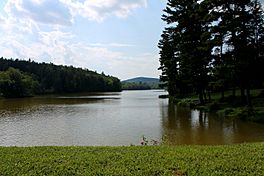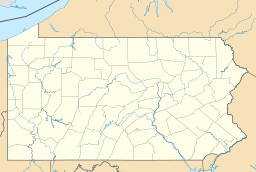Lake Louise (Pennsylvania) facts for kids
Quick facts for kids Lake Louise |
|
|---|---|

Lake Louise in August 2016
|
|
| Location | Franklin Township, Luzerne County, Pennsylvania |
| Coordinates | 41°22′57″N 75°54′49″W / 41.3826°N 75.9136°W |
| Primary inflows | Sutton Creek; two unnamed streams |
| Primary outflows | Sutton Creek |
| Catchment area | 2.69 square miles (7.0 km2) |
| Max. length | 4,000 feet (1,200 m) |
| Surface area | 56 or 67 acres (23 or 27 ha) |
| Water volume | 193 acre-feet (238,000 m3) |
| Surface elevation | 1,083 metres (3,553 ft) |
Lake Louise is a beautiful lake located in Luzerne County, Pennsylvania, in the United States. It covers about 67 acres (27 ha) of land and is entirely within Franklin Township. The lake is held back by the Lake Louise Dam. In 2012, the Lake Louise Lake Association received a special grant to help keep the lake healthy and clean.
Contents
About Lake Louise
Lake Louise gets its water mainly from Sutton Creek and two other small streams. The water then flows out of the lake back into Sutton Creek. The lake sits at an elevation of about 1,083 feet (330 m) above sea level.
Normally, Lake Louise is about 56 acres (23 ha) in size and holds about 193 acre-feet (238,000 m3) of water. It is also about 4,000 feet (1,200 m) long. The lake is located about 4 miles (6.4 km) upstream from the larger Susquehanna River.
The Lake Louise Dam
Lake Louise is created by the Lake Louise Dam. This dam is an important structure that helps control the water level of the lake. It is made of earthfill, which means it's built from compacted soil and rock. The dam is 16 feet (4.9 m) tall and 210 feet (64 m) long.
In the past, the dam needed some repairs to make sure it was as safe as possible, especially during very heavy rains. Work has been done to improve its spillway, which is like a drain that lets extra water out safely when the lake gets too full.
Lake Louise's Surroundings
The area around Lake Louise is part of a region called the Glaciated Low Plateaus, which is a type of landscape found in the Appalachian Mountains. The ground beneath the lake is made up of very old rocks from the Devonian period. These rocks include different types like conglomerate (rocks made of pebbles), siltstone, sandstone, and shale.
The land that drains into Lake Louise, called its watershed, covers an area of 2.69 square miles (7.0 km2). Most of this watershed is covered by forests. The hills and slopes in this area are generally gentle or moderate, not too steep.
Water Quality of Lake Louise
Scientists often check the water quality of lakes to make sure they are healthy for plants, animals, and people. They measure things like nitrate/nitrogen and phosphorus levels.
Nitrate and Nitrogen Levels
Nitrate and nitrogen are nutrients that are naturally found in water. However, if there's too much of them, it can cause problems like too much algae growing. In Lake Louise, measurements taken in 2007, 2009, and 2011 showed that the levels of nitrate/nitrogen were generally higher than what is considered healthy for lakes during the summer. Healthy lakes usually have less than 0.05 milligrams per liter (3.1×10−6 lb/cu ft) of these nutrients.
Phosphorus Levels
Phosphorus is another important nutrient. Like nitrogen, too much phosphorus can lead to problems like eutrophication, where the lake becomes overly rich in nutrients, causing too much plant growth and sometimes harming fish.
Measurements in Lake Louise showed that phosphorus levels were often higher than 0.03 milligrams per liter ([convert: unit mismatch])*. This level suggests that the lake is eutrophic, meaning it has a lot of nutrients.
History and Conservation Efforts
Lake Louise was officially recognized and added to the Geographic Names Information System on August 2, 1979.
To help improve the lake's health, the Lake Louise Lake Association received a special grant in 2012 called a Growing Greener mini-grant. This grant helped them work on several important projects:
- Sediment removal: Taking out mud and dirt that had built up at the bottom of the lake.
- Shoreline stabilization: Protecting the edges of the lake from erosion.
- Riparian buffer establishment: Planting trees and plants along the shoreline to filter water and provide habitat.
- Invasive species control: Managing and removing plants or animals that are not native to the lake and can harm its ecosystem.
These efforts are important to keep Lake Louise a beautiful and healthy place for everyone to enjoy.



